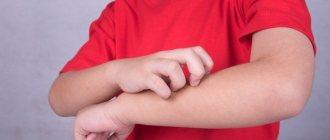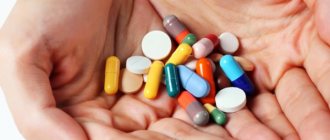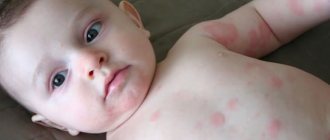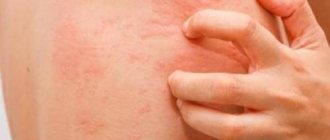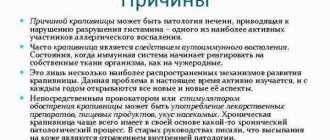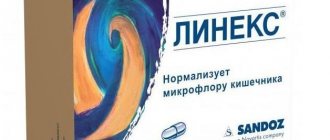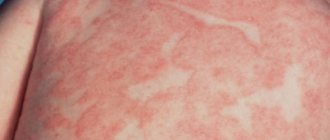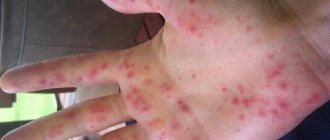Ointment for urticaria is prescribed to reduce itching, swelling, redness and irritation of the skin. Non-hormonal ones are used: Fenistil gel with a cooling effect, Zinc for weeping areas, Desitin and Bepanten to protect the skin and restore. For swelling, inflammation and severe redness, the doctor prescribes hormonal medications for 5-7 days: Advantan, Elokom. Apply Sinaflan and Hydrocortisone ointment with caution for urticaria on the face.
For allergic urticaria, the drugs Fenistil, Psilo-balm are used, and in the acute stage - hormonal. For the cold form, without an exacerbation, you need to use Panthenol and Bepanten, and for the heat form, the doctor prescribes prescriptions with belladonna extract. Ointments are usually combined with tablets: Claritin, Erius, Zodak.
What kind of ointment is there for urticaria?
Ointment for urticaria comes with hormones and non-hormonal composition. The advantages of the former are considered to be a rapid antipruritic, anti-edematous and anti-inflammatory effect. Disadvantages include addiction, dryness and thinning of the skin. Not all hormonal drugs can be used by children, pregnant and lactating women.
Non-hormonal external agents have a good ability to reduce itching and skin irritation, and their components do not harm patients. Negative properties are associated with a gradual effect; they help little in the acute stage. The most effective hormonal and non-hormonal ointments are listed in the table.
| Name | Active substance | Hormone content | Feature of the drug |
| Elokom | Mometasone | Eat | Well tolerated |
| Advantan | Methylprednisolone | Eat | Allowed from birth, safest |
| Beloderm | Betamethasone | Eat | Quickly relieves itching |
| Fenistil | Dimetinden | No | Suitable for all types of urticaria |
| Psilo-balm | Diphenhydramine | No | Effective immediately after application |
Hormonal
Hormonal ointments differ in their strength: for urticaria, the use of the strongest ones is not required (Dermovate), for an acute inflammatory reaction (swelling, blisters, redness, irritation) they start with weak ones (Hydrocortisone), and if ineffective, switch to drugs of medium strength (Prednisolone).
For severe urticaria, the following may be prescribed: Sinaflan, Elokom, Advantan, Beloderm. All drugs are used for a course of no more than 5-7 days. As soon as the severe symptoms subside, you need to cancel them, but it is better to do this gradually, reducing the amount and frequency of use.
Non-hormonal
Non-hormonal ointments contain antiallergic components (Fenistil, Psilo-balm). They are effective in the acute stage and when the condition of patients with chronic urticaria worsens. Preparations containing natural remedies (Gistan, Desitin) are best used in the stage of subsiding exacerbation.
Vitamin ointments are needed to restore the skin after a course of hormonal medications; they also help reduce the skin’s reaction to external irritants, that is, they are recommended for the prevention of rashes.
We recommend reading about what Bepanthen cream is used for. From the article you will learn about the properties of Bepanthen cream, indications for use, and features of use. And here is more information about who and when Advantan ointment is prescribed.
Reasons for development
Recurrent urticaria is the most common type of the disease. The development of numerous red rashes on the skin indicates that the body is exposed to a certain allergen, which causes organ cells to begin to produce a beneficial protein called histamine. After the release of this substance, liquid seeps through small capillaries, which over time accumulates in the layers of the epidermis and causes urticaria.
Dermatologists note that the mechanism of development of the chronic form of the disease is autoimmune in nature. All patients in this category contain LgG antibodies. It is they who activate even dormant mastocytes of the skin, thereby forcing them to attack healthy cells of the body. As a result, a severe allergic reaction develops. The main causes of recurrent urticaria can be safely called lupus erythematosus, damage to the thyroid gland, rheumatoid arthritis, and diabetes mellitus.
The chronic form of the disease is closely related to menopause, since it is during this period that natural hormonal changes occur, which can provoke activation of the pathology. In addition, urticaria can also occur under the influence of other pathologies:
- Helminthiasis.
- Viral type hepatitis.
- Hyperthyroidism.
- Dental problems (caries).
- Hypothyroidism.
- Vitiligo (the appearance of multiple white spots on the skin).
- Inflammation of the appendages in women.
Do not forget that not only diseases, but also allergens (triggers) can provoke the development of urticaria. Against this background, a person may encounter unpleasant symptoms and complications. Most often, multiple red rashes on the skin appear under the influence of the following factors:
- Drinking drinks that contain caffeine.
- Exhaustion of the nervous system due to frequent stress and depression.
- Alcoholic drinks.
- Excessive pressure on the epidermis (wearing clothes and shoes that are smaller).
- Medications (aspirin, various painkillers, opiates).
- A sharp decrease/increase in temperature.
- Consumption of food additives (specific salicylates contained in dyes, tomatoes, orange juice).
- Skin exposure to hard, chlorinated water.
- Various insect bites.
- Regular use of ACE inhibitors, which are effective in combating hypertension. In some cases, angioedema may occur.
What and when to use ointment for urticaria on the skin of adults
The choice of ointment and cream for urticaria on the skin in adults depends on the form of the disease: allergic, cold, heat, cholinergic or papular. Fenistil gel and hormonal ointments are considered the most universal.
For allergic
For allergic urticaria, hormonal drugs will best help with severe exacerbation (Advantan, Elokom, Beloderm, Hydrocortisone, Sinaflan). For moderate redness and itching, use drugs with antiallergic components, but without hormones - Fenistil, Psilo-balm.
The use of external agents with a natural composition, as well as any new drug, should begin with a test for individual tolerance. To do this, it is recommended to apply the ointment to the elbow and after 15 minutes assess the condition of the skin - in case of redness and irritation, the drug is contraindicated.
From cold and heat
For cold urticaria, the greatest effectiveness was noted from the use of hormonal drugs - Elokom, Advantan, Sinaflan. Protective agents are also used to reduce reactions to irritants, for example, Bepanten and Panthenol ointments.
And with the second variant of temperature urticaria - thermal, they all help little, the doctor prescribes ointments with Atropine or belladonna extract to patients. They are not sold ready-made; they are prepared in a pharmacy according to an individual prescription. Some patients use a mixture of candles melted in a water bath with belladonna and Vaseline in equal parts. After cooling, apply this mixture to the skin 1-2 times a day.
Cold urticaria
From cholinergic
Cholinergic urticaria occurs when there are disorders of the immune system, when stress, taking a hot bath, or physical activity become a provoking factor for the rash. Since the disease occurs as an immediate allergic reaction, it makes sense to use only ointments that help against allergies - Fenistil, Psilo-balm and all hormonal ones in acute cases.
From papular
Papular urticaria occurs in response to insect bites; it is helped by drugs with a pronounced antipruritic effect - Psilo-balm, Gistan, Fenistil. If they are ineffective, hormones are added to them for 2-3 days. It is very important between exacerbations to use ointments that normalize the condition of the skin - Bepanten, Panthenol.
Watch this video about the causes and symptoms of urticaria:
Definition of disease
Heat urticaria and its antipode, cold urticaria, are considered types of temperature urticaria, which affects about 7% of the world's population. It most often occurs among children and young people, although many cases have been recorded among older people.
Dermatologists distinguish two forms of heat urticaria:
- local. Occurs at the site of direct skin contact with a heat source.
- cholinergic. It is a non-standard reaction of the body to an increase in internal temperature and can appear in the following situations:
- when visiting a sauna or steam bath;
- after a hot bath or shower;
- while walking in hot weather;
- after sports or other physical activity;
- when consuming hot foods and drinks or alcohol;
- for various diseases accompanied by increased body temperature;
- as a result of severe nervous excitement or stress.
Skin rashes can appear in women during menopause against the background of periodically occurring “hot flashes”, accompanied by increased sweating.
The best ointments for urticaria in adults with itching and how to use them
For itchy skin in adults against the background of urticaria, ointments without hormones are prescribed: Fenistil, Psilo-balm, Zinc. For prevention and recovery, Bepanten and Panthenol are used. In case of exacerbation, Advantan, Elokom, Hydrocortisone, Sinaflan are used in a short course. After the acute process has subsided, the doctor may recommend Gistan and Desitin.
All medications are applied only to the area of the rash with a thin layer. During the acute stage, it is not recommended to rub in the ointment; it is carefully applied to the skin in a thin layer, since any mechanical irritation increases the itching and leads to the spread of rashes. After the exacerbation subsides, a light massage is allowed to speed up the absorption of the external remedy.
Fenistil
Fenistil contains dimethindene, which helps against all types of urticaria, as it has a fairly strong anti-allergic and antipruritic effect. Its properties:
- reduces the permeability of small vessels caused by allergies (anti-edematous effect);
- reduces itching and skin irritation;
- slows down the reaction to external stimuli (local anesthetic and cooling effect);
- relieves inflammation.
After application, the effect occurs immediately and lasts up to 4 hours. Penetrates well into the skin, and no more than 10% of the active substance passes into the blood. Used for application to the affected area in a thin layer without rubbing 2-4 times a day. May in rare cases cause burning and dryness. When using Fenistil, you should not sunbathe.
Recommended with caution during pregnancy and breastfeeding (do not apply to the skin near the nipples); contraindicated for glaucoma and prostate enlargement.
Zinc
It is advisable to use zinc ointment for urticaria only on wet areas, since its main effect is drying, astringent, and absorbent. In all other cases, it greatly dries out the skin. Apply a thin layer to the affected area 2-3 times a day.
Sinaflan
Sinaflan contains the hormone fluocinolone. It quickly reduces inflammation and swelling of the skin, redness, but the antipruritic effect is felt after 1-2 days of regular use. Prescribed for urticaria according to the rules:
- no more than 5 days;
- applied to the palm-sized surface of the skin;
- lubricate with a thin layer;
- apply 2-4 times a day.
With longer treatment, thinning of the skin, discoloration, and dilation of small blood vessels occur. When used on the face, Sinaflan provokes acne and hair growth. Contraindicated for infectious skin lesions, trophic ulcers, wounds, cancerous tumors, pregnancy, lactation.
Bepanten
Bepanten has a very weak antipruritic and anti-edematous effect; it helps more with the healing and restoration of the skin, so for urticaria it can be used after the acute inflammation has subsided. The drug is also recommended for restoring the skin of the face and hands after a course of hormonal ointments.
Approved for children from birth, nursing (applied to the mammary glands after feeding), and pregnant women. Apply 1-2 times a day with a light massage. There are no course duration restrictions required.
Beloderm
Beloderm contains betamethasone, it is considered the optimal treatment option for acute urticaria. This is explained by a fairly strong and rapid effect, which allows the drug to be used in a short course. Has a minimum of side effects. Properties of the ointment:
- relieves itching and redness;
- reduces inflammation and skin irritation;
- stops the progression of allergic reactions;
- constricts blood vessels.
Long-term use on the face, especially in the eye area, is not recommended. When applied in areas of skin folds (inguinal, axillary), a course of no more than 3 days is recommended. The ointment is contraindicated for skin infections, injuries, syphilis, and chickenpox. Apply a thin layer to the affected area 2 times a day. Analogues in composition: Celestoderm, Betamethasone, Akriderm.
Sulfuric ointment
Sulfur ointment is not indicated for urticaria; it is used for itchy skin caused by scabies (infestation with scabies mites). Doctors rarely prescribe this drug for microbial origin or bacterial complications of the disease. Rubbed into the skin once a day alone or in combination with Prednisolone. Often, when applying sulfur ointment, skin itching intensifies and chronic allergic dermatoses, including urticaria, worsen.
Advantan
Advantan ointment contains methylprednisolone, which is characterized by a rapid reduction in discomfort during urticaria. Relieves itching, burning, soreness, redness and swelling. It is important that among all hormonal drugs it is considered less dangerous, since it acts in the skin and is practically not absorbed into the blood. It extremely rarely causes adverse reactions.
Apply once a day; for urticaria, it can be used for up to 2 weeks. During the treatment period, you should be careful not to get the ointment into your eyes. The drug is contraindicated in infectious diseases; it is prescribed with caution to pregnant and lactating women (away from the mammary glands). Analogues in composition: Comfoderm, Comfoderm K.
Desitin
Desitin has a protective effect against urticaria, contains zinc oxide, vitamin E, and aloe juice. When applied, it forms a coating that reduces the effect of irritating factors. Can be used for a long time, applied in a thin layer 1-2 times a day on the face, hands, and exposed parts of the body.
Panthenol
Panthenol has a healing and restorative effect on the skin, cools slightly and relieves mild inflammation. It is used for urticaria only outside the acute stage of the disease, since the components of the drug can cause an increase in the allergic reaction. Helps with cold and aquagenic (from water) urticaria, as it covers the skin with a protective layer. Panthenol should not be applied to wet areas.
Hydrocortisone
Hydrocortisone ointment has pronounced anti-inflammatory and antipruritic effects, reduces redness and swelling in urticaria. If the drug has not been used before, then you need to carry out a test application on the skin fold, since the drug can provoke skin irritation with increased sensitivity.
Apply a thin layer of ointment to the affected area 2-3 times a day. Hydrocortisone ointment should not be used for more than 7 days. It is recommended with caution for urticaria on the face and décolleté, since even a short course can cause dilation of small capillaries, thinning, and dehydration.
Psilo-balm
Psilo-balm contains an antiallergic component – diphenhydramine. It quickly relieves skin itching, redness and swelling, cools and soothes irritated skin. Apply 3-4 times a day, a single dose is a column of cream about 4 cm, it is distributed over the surface of the skin equal to the size of the patient’s palm. You should not go out into the sun for 1-2 hours; alcohol is prohibited during the treatment period.
Elokom
Elokom contains mometasone, which acts quickly and strongly, but no more than 0.4% of the active substance penetrates into the bloodstream. The drug is well tolerated by most patients. For urticaria, it is prescribed for 3-7 days once a day.
After the acute inflammation subsides, it is better to gradually reduce the dosage; you can use the ointment every other day. Contraindicated for infections; not prescribed for urticaria in pregnant and lactating women. Analogs: Mometasone, Momat, Avekort.
Gistan
Gistan contains panthenol, extracts from string and birch buds, vitamin B6 and lavender oil. When applied:
- soothes sensitive skin;
- relieves redness and irritation, itching and soreness;
- helps recovery;
- eliminates dryness and flaking;
- has an antiallergic effect.
Apply a thin layer for chronic urticaria, apply with slight rubbing 2-4 times a day.
Short description
Chronic urticaria refers to a category of skin diseases that are accompanied by severe itching, as well as the development of red (erythematous), painless blisters. Statistics show that the prevalence of this disease is quite high. More than 25% of the world's population experiences urticaria. Multiple reasons can provoke the development of red rashes on the skin. That is why this pathology is considered one of the most difficult in terms of quality diagnosis and treatment.
Depending on the etiology and degree of neglect, experts distinguish two forms of the disease:
- Chronic. The disease occurs with frequent relapses, which are accompanied by painful symptoms. Most often, the rash lasts on the skin for about two months. Periods of remission are always followed by exacerbations, and this clinical picture can be observed for years. Experts have found that chronic urticaria is rarely provoked by ordinary allergens; most often, skin rashes appear as a result of the activation of a concomitant pathology, infection, virus or autoimmune lesion. This disease is diagnosed extremely rarely in children; most often it affects the adult population.
- Spicy. In 98% of all cases it is of an allergic nature. The duration of the disease can vary from several days to three weeks. After this, all symptoms disappear.
Urticaria ointment for children
Urticaria ointment for children can only be used taking into account age restrictions and dosages (see table).
| Name | From what age | Single dose, column length | How many times to lubricate per day | Course of treatment, in days |
| Advantan | From 4 months | 0.5 cm | 1 | 3-5 |
| Fenistil | From 1 month | 1-2 cm | 2-4 | 3-10 |
| Bepanten | From birth | 1-3 cm | 1-2 | Long-term |
| Desitin | From birth | 1-3 cm | 1-2 | Long-term |
| Psilo-balm | From 2 years | 2-4 cm | 3-4 | Up to 7 days |
To relieve itching, small children are recommended to take baths with a decoction of string, chamomile, and sea salt. Newborns can use the drug Flotseta baby. It contains extracts of chamomile, witch hazel, and calendula. The gel has an anti-inflammatory effect, reduces redness and swelling of the skin. Apply 3 times a day in a thin layer, apply for a long time until a sustainable improvement in skin condition.
Diagnostics
If you experience symptoms of heat urticaria, you should make an appointment with a dermatologist or allergist. After a visual examination and questioning of the patient, the doctor will prescribe a series of tests that will help identify the cause of urticaria.
These include:
- the patient’s hand is lowered into a bath of hot (48-500C) water for 3-5 minutes or a glass with liquid heated to the same temperature is applied to the forearm;
- a person is asked to exercise for 20-30 minutes on an exercise bike or treadmill to provoke sweating and an increase in body temperature;
- Acetylcholine is injected subcutaneously, which in the presence of cholinergic urticaria gives a reaction within 20 minutes.
To identify concomitant diseases, the doctor may give a referral for blood, urine, stool, and ultrasound examination of the abdominal organs. In some cases, consultations with other specialists are required: gastroenterologist, immunologist, endocrinologist, neurologist.
Based on the research results, the dermatologist makes a final diagnosis and prescribes treatment.
What tablets should be used to supplement the treatment of urticaria with ointment?
Even the strongest ointment only temporarily relieves the symptoms of urticaria, since the disease is of allergic origin, tablets are always prescribed at the same time:
- fexofenadine – Allegra, Telfast;
- loratadine – Clarisens, Claritin;
- sehifenadine – Histafen;
- cetirizine – Zodak, Cetrin;
- desloratadine – Erius, Blogir-3;
- calcium gluconate;
- enterosorbents and probiotics – Laktofiltrum, Enterosgel, Dufalak;
- calming – Novo-passit, Persen.
In severe cases, hormonal drugs for oral administration and cytostatics are added. The choice of medications is always made after the examination; the regimen for each patient is selected individually.
We recommend reading about how to choose an ointment for bruises. From the article you will learn why and how to use ointment for a bruise, recommendations for use, contraindications. And here is more information about the characteristics and features of the use of Troxevasin ointment.
Ointment for urticaria can be non-hormonal with antiallergic or herbal components that have antipruritic and decongestant effects. For acute inflammation, hormonal medications and tablets are indicated.

